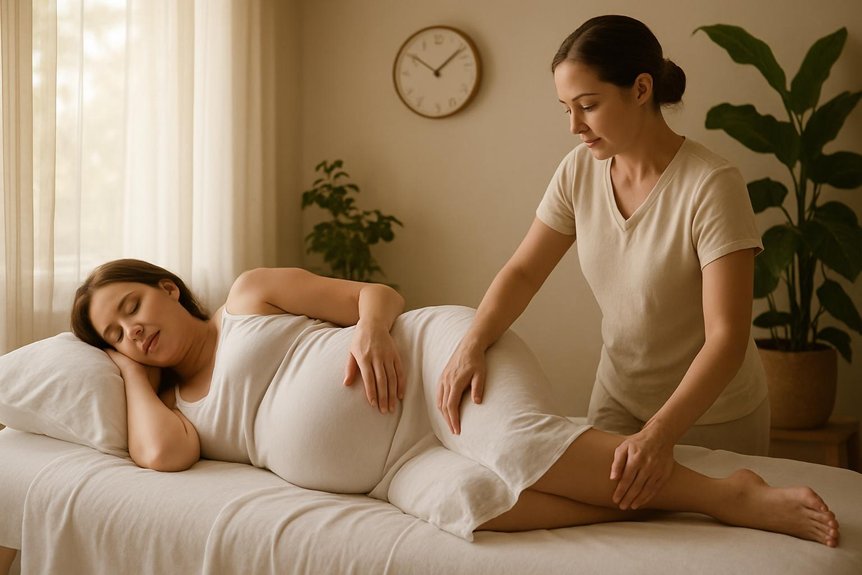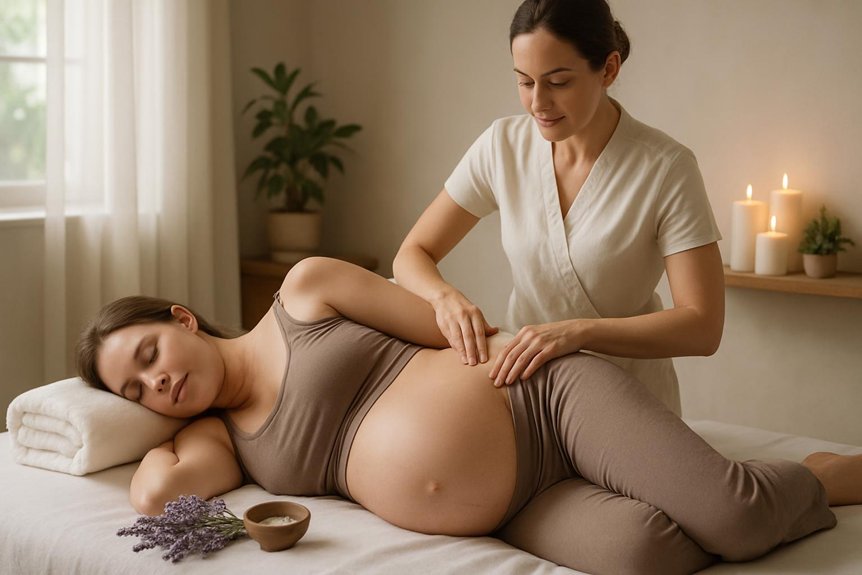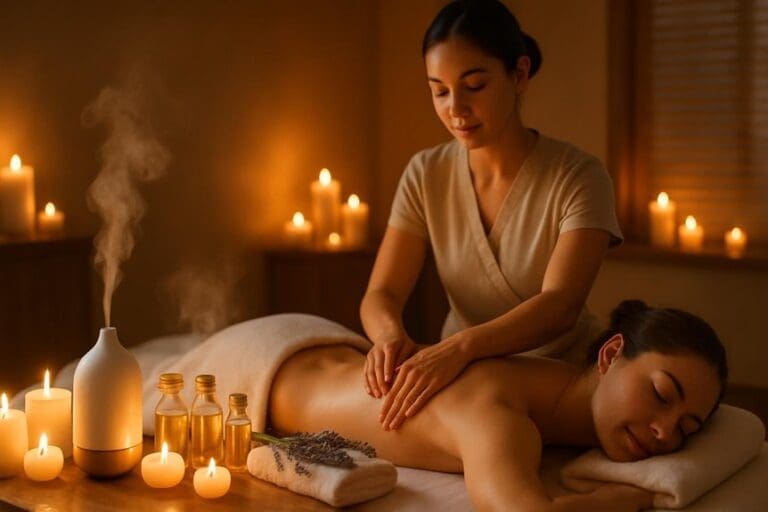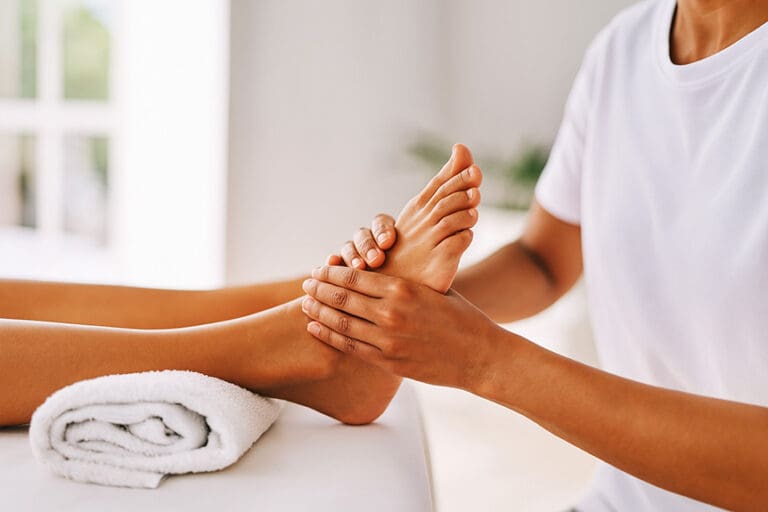Current evidence does not support prenatal massage as a reliable way to start labour. Small studies are mixed and low quality, and causation is unclear. Massage can safely reduce pain, anxiety, and improve sleep when tailored and screened appropriately. Avoid deep abdominal work, strong pressure, and known “labour” acupressure points, especially before term. Contraindications and red flags require medical review. Massage should be considered supportive care, not induction. Further details explain safe timing, techniques, and when to seek advice.
What the Evidence Says About Massage and Labour Onset

How strong is the evidence that massage can trigger labour? Current data are limited and low certainty.
Small randomized and observational studies on prenatal massage, reflexology, and acupressure show mixed findings, with many underpowered, poorly blinded, or combining multiple interventions (touch, oils, points), making causation unclear.
Meta-analyses suggest possible improvements in discomfort, anxiety, and sleep, but no consistent reduction in time to spontaneous labour or induction rates.
From Spa & Massage’s clinical perspective, massage is best viewed as supportive care—reducing stress, easing musculoskeletal tension, and enhancing comfort—rather than a reliable method to start labour.
Risk remains low when techniques are gentle and non-provocative.
Our therapists avoid targeted acupressure points associated anecdotally with uterine activity and tailor sessions to soothe without stimulating contractions.
Aromatherapy is often incorporated into prenatal massage and can provide additional relaxation benefits, as discussed in our aromatherapy massage tips.
Safe Timing for Pregnancy Massage by Trimester
Given the limited evidence that massage reliably initiates labour, timing should prioritise maternal-fetal safety and symptom relief rather than induction aims.
In the first trimester, routine relaxation-focused massage may be considered after medical review, avoiding deep abdominal work and strong pressure over sacrum or acupressure trigger points; any bleeding, severe nausea, or miscarriage risk warrants deferral.
In the second trimester, positioning in side-lying with supported cushions reduces vena cava compression; moderate pressure to relieve back, hip, and leg tension is generally appropriate if pregnancy is uncomplicated.
In the third trimester, sessions can continue with vigilant screening for preeclampsia, reduced movements, or preterm labour signs.
At Spa & Massage, therapists adapt frequency and duration, coordinate with obstetric guidance, and stop treatment if red flags arise.
Techniques We Use to Support Comfort Without Inducing Labour
At Spa & Massage, therapists prioritise gentle, adaptive positioning to maintain uteroplacental blood flow and reduce musculoskeletal strain. They use side-lying or semi-reclined setups with appropriate bolstering.
Pressure is kept light-to-moderate, avoiding known contraindicated points and deep work that could increase discomfort or theoretical uterine stimulation.
Sessions incorporate calming breathwork focus to modulate autonomic tone, aiming to lower pain perception and anxiety without affecting labour onset.
Gentle, Adaptive Positioning
Why prioritise positioning in prenatal massage? Because maternal positioning directly influences uteroplacental blood flow, nerve compression risk, and client comfort—key factors when aiming to soothe without stimulating labour.
At Spa & Massage, therapists use left side-lying or semi-reclined setups with adjustable wedges and bolsters to reduce vena cava pressure, protect the pelvis, and support the abdomen and breasts. Neutral spinal alignment and hip abduction are maintained to minimise sacroiliac strain.
Therapists reassess placement throughout the session, adapting to breath, fetal movements, and client feedback. Pillowing between knees and under the bump limits torsion; slight torso elevation helps reflux and breathing.
Clients are guided to shift gradually to prevent orthostatic symptoms. These evidence-aligned strategies favour parasympathetic calm, mitigate musculoskeletal load, and maintain safety while nurturing closeness and ease.
Light-To-Moderate Pressure
A light-to-moderate pressure approach reduces autonomic arousal and minimises theoretical risks of stimulating uterine activity while still addressing myofascial discomfort.
Evidence suggests moderate pressure can downregulate stress physiology and relieve low-back, hip, and shoulder tension without provoking cervical change.
At Spa & Massage, therapists apply graded, slow strokes—effleurage, gentle kneading, and sustained, superficial-to-mid depth holds—avoiding strong trigger-point compression and acupressure near the abdomen, sacrum, and medial lower leg.
Pressure is titrated to client feedback, with continuous monitoring for guarding, breath-holding, or referred pain.
Neutral, hypoallergenic oils are used to reduce friction and permit precise control.
Sessions prioritise symmetrical work, shorter durations over sensitive areas, and frequent check-ins.
This protocol supports comfort, circulation, and rest while maintaining a conservative safety margin.
Calming Breathwork Focus
Building on light-to-moderate pressure protocols, calming breathwork is incorporated to regulate autonomic tone without increasing uterine activity. Evidence suggests slow diaphragmatic breathing (4–6 breaths per minute) reduces sympathetic drive, lowers perceived pain, and supports maternal heart rate variability, without triggering oxytocin-mediated contractions.
At Spa & Massage, therapists cue nasal inhalation, soft jaw release, and prolonged exhales (e.g., 4-in/6-out) to promote parasympathetic dominance and pelvic floor ease.
Risk controls include avoiding breath holding, hyperventilation, and intense “bearing down” patterns. Positions are adjusted—left lateral or semi-reclined—to optimise venous return and respiratory comfort.
Verbal pacing remains quiet, intimate, and measured to avoid arousal. Clients are advised to continue gentle breath cycles post-session for sleep and anxiety support.
Any uterine cramping, dizziness, or breathlessness prompts immediate modification or cessation.
Pressure Points: Myths, Precautions, and Professional Practice
How reliably do “pressure points” influence labour onset and comfort? Evidence is mixed. Small trials suggest acupressure may modestly ease contractions once labour is established, but data do not show consistent induction of labour. Myths persist around points such as SP6, LI4, and BL32; stimulation before term is discouraged due to theoretical uterine effects, yet high‑quality causal proof is lacking.
Spa & Massage follows a precautionary protocol: no acupressure aimed at induction, no deep or sustained pressure on “forbidden” points, and clear documentation of gestation, symptoms, and obstetric advice.
Therapists use gentle, non‑provocative holds, prioritising comfort, circulation, and anxiety reduction. Any cramping, bleeding, decreased fetal movement, or medical complications trigger immediate referral. The guiding principle is intimacy with safety: soothe, never stimulate labour.
Benefits of Prenatal Massage for Sleep, Pain Relief, and Stress
With induction-focused techniques set aside for safety, attention turns to evidence-supported outcomes of prenatal massage: sleep quality, musculoskeletal pain, and stress physiology.
Research indicates moderate improvements in sleep continuity and latency, likely via parasympathetic activation and reduction in cortisol and catecholamines.
Low-back, pelvic, and gluteal pain—often driven by postural load and ligamentous laxity—show clinically meaningful reductions after structured sessions.
In Spa & Massage clinics across London, therapists apply side-lying positioning, light-to-moderate pressure, and slow myofascial strokes to high-burden regions while monitoring comfort and fetal-safe positioning.
Neutral, hypoallergenic oils are used to minimise dermal reactivity.
Clients are counseled on pacing, hydration, and home positioning to sustain gains.
While responses vary, a consistent pattern emerges: calmer autonomic tone, eased nociception, and more predictable rest without pursuing labour-stimulating methods.
When to Avoid Massage and When to Seek Medical Advice
Prenatal massage is contraindicated in certain situations, including unexplained vaginal bleeding, preeclampsia or uncontrolled hypertension, severe swelling with headache or visual changes, fever or infection, placental complications, and a history of preterm labour or recent trauma.
Spa & Massage therapists screen for red flags and will defer treatment if any warning signs are present or if a GP/midwife has advised against massage.
Clients should contact their midwife urgently if they experience reduced fetal movements, persistent abdominal pain, leaking fluid, regular contractions before 37 weeks, new neurological symptoms, or any sudden worsening of symptoms.
Contraindications for Maternity Massage
A clear understanding of contraindications helps guarantee that massage in pregnancy remains safe and effective. At Spa & Massage, therapists screen for red flags before every session and adapt or defer treatment when risk is identified.
Massage should be avoided with unexplained vaginal bleeding, suspected preterm labour, ruptured membranes, placenta previa or accreta, severe preeclampsia, significant hypertension, fever or systemic infection, acute deep-vein thrombosis, pulmonary embolism history without medical clearance, severe anaemia, or uncontrolled gestational diabetes.
Local massage is avoided over recent abdominal pain, surgical scars not fully healed, active rashes, bruising, or areas of loss of sensation. Caution is used with nausea, severe oedema, sciatica flares, symphysis pubis dysfunction, and first-trimester miscarriage history.
Our therapists prioritise side-lying positioning, light-to-moderate pressure, and medical referral when symptoms suggest instability or escalating risk.
When to Contact Your Midwife
When should a pregnant client pause massage and call a midwife?
If there is vaginal bleeding, fluid leakage, reduced or absent fetal movements, persistent headache, visual changes, chest pain, shortness of breath, right‑upper‑quadrant pain, sudden swelling of face or hands, fever, or severe abdominal pain, massage should stop and medical advice sought immediately.
Regular contractions before 37 weeks, back pain unrelieved by rest, or rhythmic pelvic pressure also warrant urgent assessment.
Clients with placenta previa, preeclampsia, gestational hypertension, cholestasis, or known cervical insufficiency should avoid massage unless cleared by their maternity team.
At Spa & Massage, therapists screen for red flags, adapt positions, and avoid abdominal or acupressure points linked to uterine activity.
Any new symptom after a session is documented, and clients are guided to contact their midwife without delay.
How We Personalise Maternity Massage at Spa & Massage
Why personalise a prenatal treatment? Individual risk profiles vary. At Spa & Massage, therapists begin with a structured health screen: gestational age, pregnancy history, current symptoms, obstetric guidance, and red flags (e.g., reduced fetal movements, bleeding, sudden swelling).
Positioning is adapted—typically left-side lying with pillows to reduce vena cava compression—avoiding prolonged supine time. Pressure is moderated to client tolerance, with caution over oedematous limbs and avoidance of deep work on the abdomen and known acupressure induction points.
Oil choice is conservative; in our clinics, unscented or low-allergen blends are preferred, applied minimally to maintain grip and stability. Sessions prioritise evidence-aligned goals: reducing low-back and pelvic girdle discomfort, easing thoracic tightness, and supporting sleep.
Aftercare reinforces hydration, gentle mobility, and clear thresholds for contacting a midwife.
Conclusion
In late pregnancy, prenatal massage is best viewed as a calm harbor, not a launch signal. Evidence indicates relaxation, improved sleep, and pain relief, but no reliable induction of labour. With trimester-appropriate positioning, gentle pressure, and avoidance of debated acupressure points, risk remains low when clinicians screen carefully for contraindications. Like steady hands guiding a vessel at dusk, trained therapists support comfort while watching for warning lights—pre-eclampsia signs, reduced fetal movement—prompting referral so mother and baby remain safely on course.



